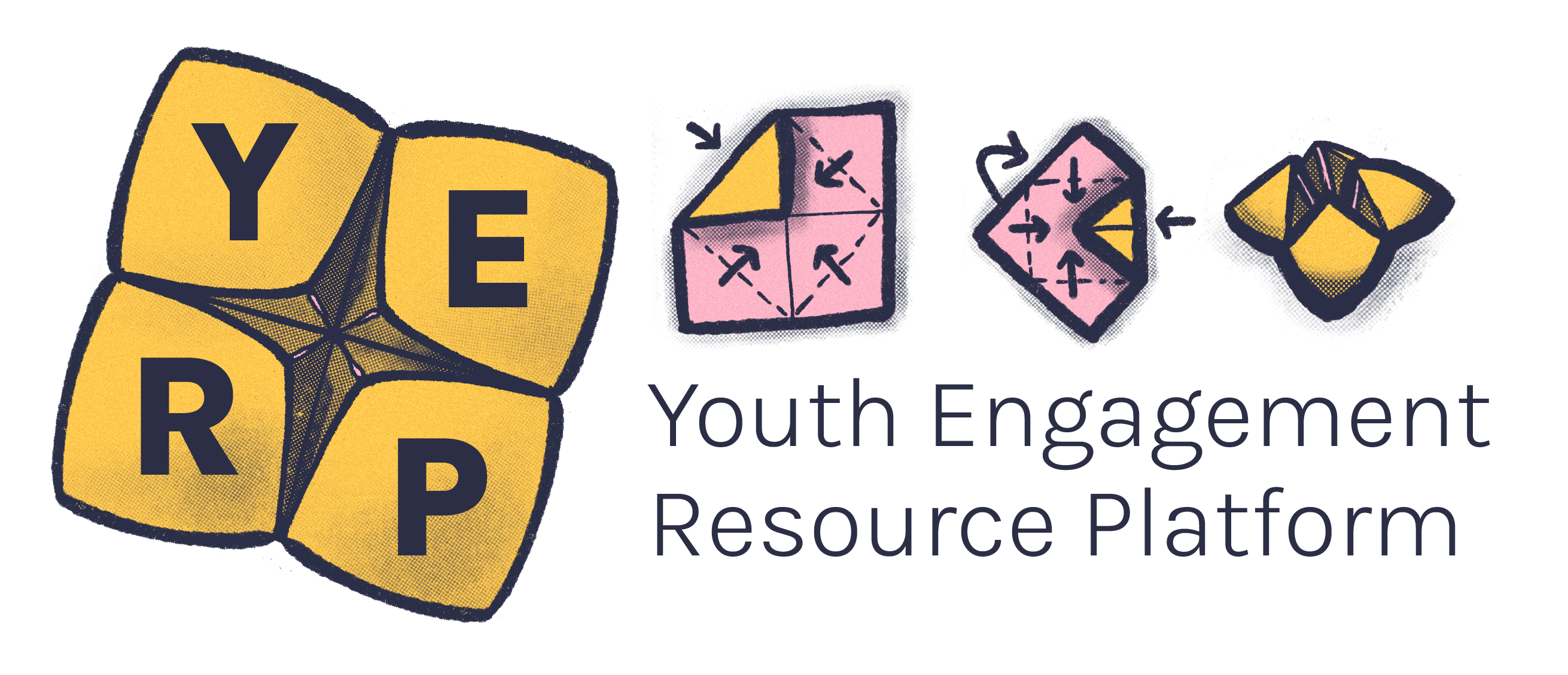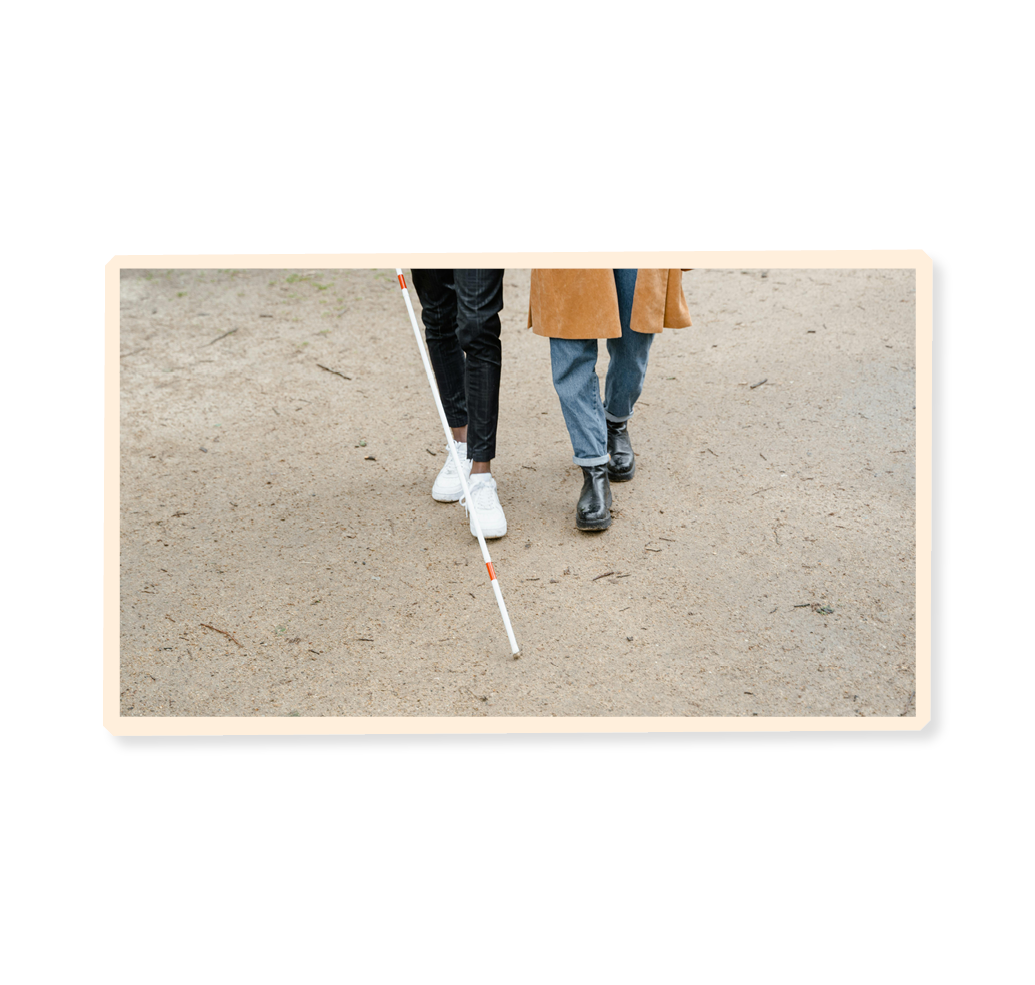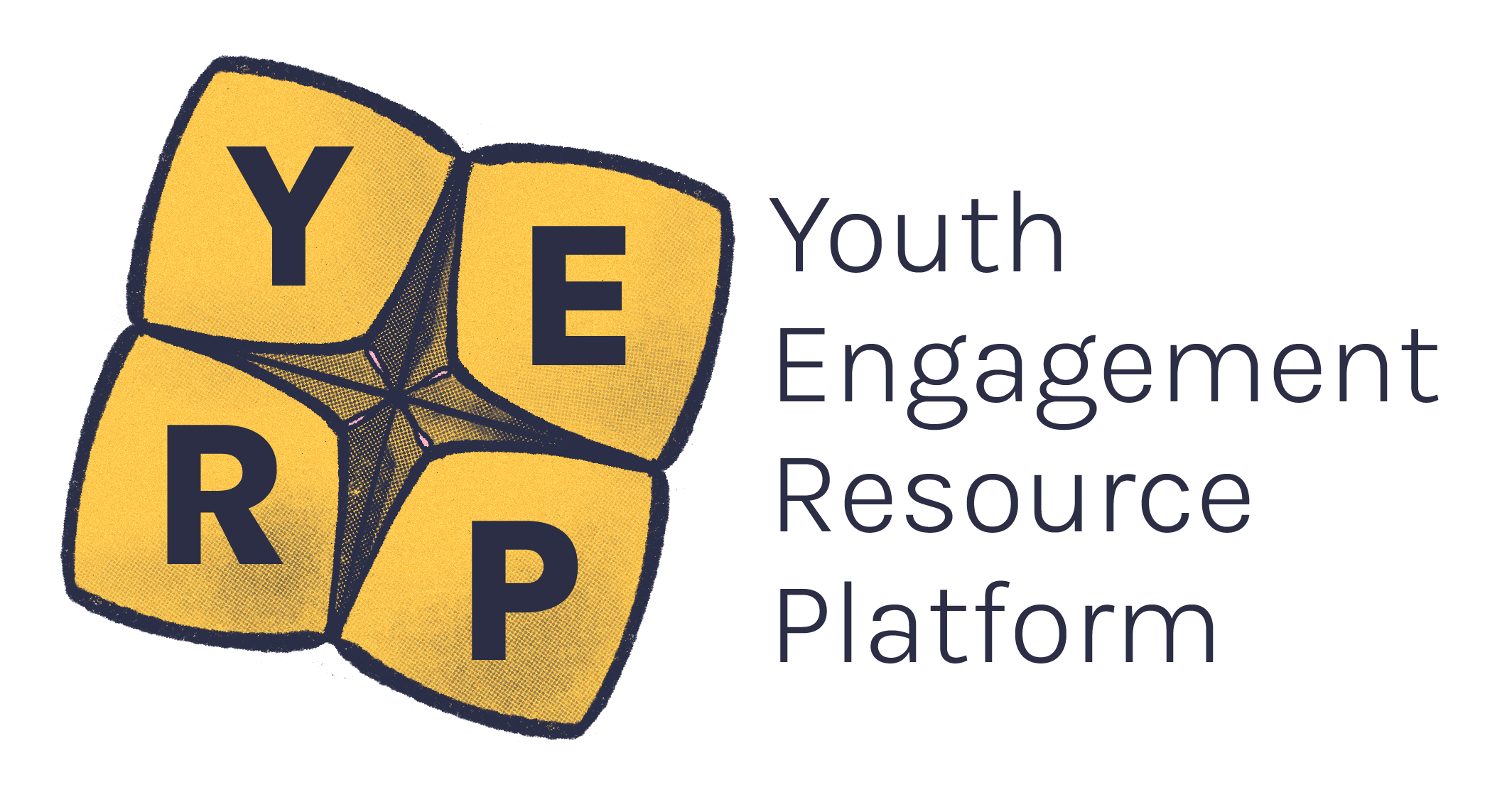YACVic acknowledges the incredible leadership of Youth Disability Advocacy Service (YDAS), and we encourage you to check out their resources and trainings for yourself and your organisation.
Access needs are things a person needs to participate, communicate or learn. Often, you’ll hear the term ‘access needs’ used in reference to the things a disabled young person might need to participate in your service, event or program. However, most people have access needs!1
Examples of access needs include:
- Ramps or elevators for people who use wheelchairs or other mobility aids.
- Bright lighting for people with low vision.
- An Auslan interpreter for people who are D/deaf or hard of hearing.
There are a range of reasons you might ask someone for their access needs, including:
- They’re attending an event you’re hosting.
- They’re a participant in a program or service you provide.
- You're having a meeting with them.
By asking for someone's access needs, you can ensure your event or program is accessible for them and everyone can enjoy it.
We’ve tried to offer some examples of considerations you might make.1,2
- Ramps
- Wide doorways
- Hallways/walkways
- Spaces such as toilet cubicles, low benches and tables, ensuring that devices or appliances are reachable for people using mobility devices.
- If you are online, let them know it’s okay for them to have their camera off.
- Use audible announcements, minimum of size 12 font and magnifiers.
- People may also require written information in another format (such as white text on a black background) and Plain English versions.
- Reduce glare
- Increase contrast
- Replace fluorescent lightbulbs with softer toned lightbulbs and ideally with ones that have the option to dim.
- Be mindful of programs and lightings that use ‘flashes’ – they can trigger seizures
- Auslan interpreters, captioning (captioning can be automatic or live. Live captioning is often more accurate than automatic captioning)
- Ask the person how to best run the sessions with the animal present
- Ask for things they’ve liked about events in the past when they have used a service animal
- Make sure to let others know that there is a service animal present and they are there for support for the person, not to be played with by others.
- For this access need, it's usually best to ask the person ahead of the event/ program or meeting what usually works for them.
- Let them know what you're trying to achieve and what activities are planned.
- Have multiple ways that people can contribute their thoughts that isn’t just writing it down. I.e. you can offer to write it down for them or they can verbally share with the group.
- Have technology available for them to use to write down what they want to say, i.e laptops or notepads.
- People may use Augmented and Alternative Communication (AAC) devices, so just reach out to them prior to the event of program to understand what they need and how to best run the program with these devices present.
- Limit fragrances and chemicals in the space in general.
- If you learn of a specific fragrance or allergy that a person has, request that people not use it during the event, program or meeting.
- Everyone needs breaks and its ideal to have a 5-minute break every half an hour but if that’s not possible, a 5-10 minute break every hour is best practice.
Please note that this list isn't exhaustive and people’s access needs often go beyond what's listed above and can be highly variable.
Remember, it’s best practice to ask someone about their individual access needs.1 This centers their agency and is a lot better than assuming.
-
What are you trying to learn?
-
How important is the question (responsibility vs. curiosity)
-
How much do you really need to know?
With these in mind, focus on the person’s access needs rather than asking them about their disability – in some situations it may be inappropriate to ask about someone’s disability. Think about the context you're in and what you're trying to find out and why.2
Sometimes what one person needs isn't compatible with the access needs of someone else, in other words, there are 'conflicting access needs'.2 It’s a common situation you will experience when working with young people.
YDAS recommends you try and accommodate both access needs if possible.
- For example, if one young person needs bright lighting and another needs dim lighting, could you hold your event across two rooms with different lighting. We understand that this isn’t always possible given time and budget constraints, so another way to handle this is to chat to the young people and find a compromise.2
- Once you have gained consent to share the young people's access needs, let them know there has been a conflict and you're working on a compromise.
- A compromise might be buying or collecting lamps with warm bulbs to dim the lighting or purchasing sunglasses for the young person who needs low lighting. If there are no lamps available, you could also set up a hybrid option, so that either of the young people can join online.
Be open and transparent with young people when it comes to conflicting access needs. Let them know you want to find a solution that everyone is comfortable with and lets everyone take part in a way that’s comfortable for them.
A photo of a young person communicating using Auslan.

Asking for someone's access needs is best practice and should be done in a mindful and respectful way. There is no need to ask for specifics about someone's disability. Listen attentively to someone when they tell you their access needs and be transparent about what you have the capacity to accommodate.1
Before you ask someone about their access needs, YDAS recommends that you think through the below questions:1
- What is your relationship with the person?
- How important is this question in the context of their ability to participate?
- How will their answer impact you, your event or program and are you willing to make changes and adjustments?
- How will you preface or bring up the question?
- When is the best time to ask the person this question?
- How can you give the person power in their response?
- How much do you need to know?
- How can you offer the person the option not to answer?
Remember, not everyone knows what their access needs are when you ask for them, asking them might be the first time they’ve considered they have access needs. It’s worth explaining what access needs are to a young person, either in general or specific to your context1.
It might also be difficult for a young person to tell you what their access needs are if you haven’t given them much detail about the event in advance. Be patient with young people as they figure out what they require and allow multiple opportunities for them to let you know.
Also, mental and physical health change over time, so don't assume you know someone’s access needs because you’ve asked them before.
The image is of blue speech bubbles with scripts inside them.
Heading reads: Ways to ask someone for their access needs.
The first speech bubbles reads:
“Do you have any access needs I can fulfil to allow you to participate in this in person event?”
The second speech bubbles reads:
“Would you like any support or adaptions made to be able to participate fully in this Zoom event?”
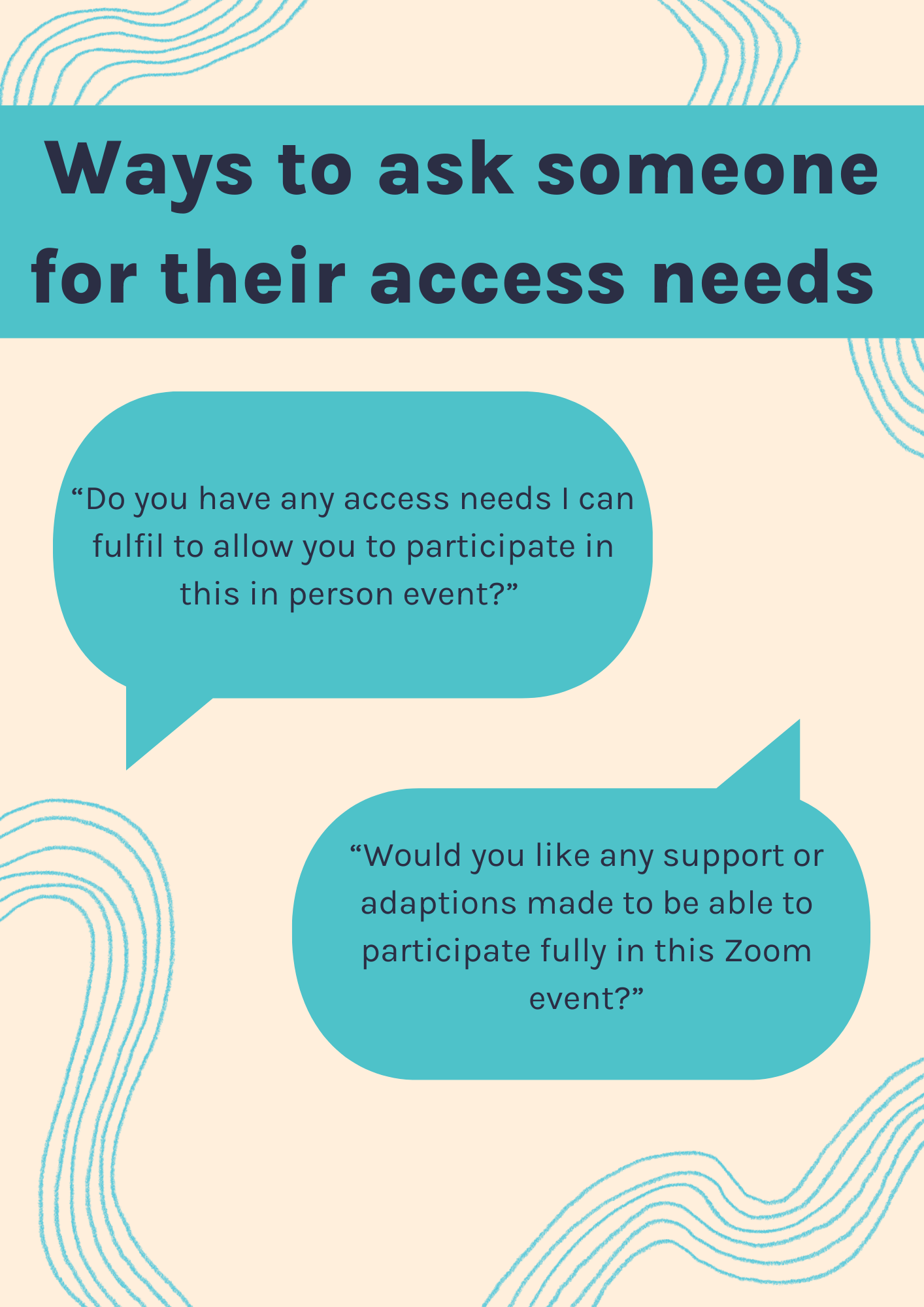
Scenario One
A young person has inquired to be part of the FReeZA committee you lead. You have set up a time to meet and get to know them and understand how you can support them as a group member. The meeting goes well, and you decide you want to invite the young person to join the FReeZA crew. As part of the induction process you’d like to ask them about their access needs.
You tell the young person they've been accepted into the committee, and say; “We aim to make the FReeZA crew as inclusive and accessible as possible, so I just wanted to check whether you have any access needs that we can support you with so you can participate in the committee? You can always let me know at any point while you’re part of the committee if your access needs change.”
Scenario Two
You’re hosting a dance event for young people in your area that’s ticketed. To promote the event you create flyers, social media content and a website that includes the contact details (email and phone number) of the worker who is organising access needs for the event.
Young people need to register for a ticket for the event online. The registration questions include:
- A multi select question that asks, “do you have any accessibility needs?”, and the options include:
- Auslan interpreting
- Automatic captions
- Live captions (instead of automatic captions)
- Breaks
- Avoid seizure inducting imagery or content
- I will have a support worker or carer with me
- Audio descriptions
- Something else (this is an open response box)
- None of the above
- An open text response question asking, ‘Any details about your accessibility needs?’ to allow someone to explain more about their situation if they choose.
Here is an example of an access needs form you could provide:
Heading reads: Access needs
Second line reads: What do you need to comfortably take part in an online event? Below are common options but please add anything else.
-
Auslan interpreting
-
Automatic captions
-
Live captions (instead of automatic captions)
-
Breaks
-
Avoid seizure inducting imagery or content
-
I will have a support worker or carer with me
-
Audio descriptions
- Other, please describe
-
None of the above
Text at bottom of form reads: please let us know any additional information about your access needs:
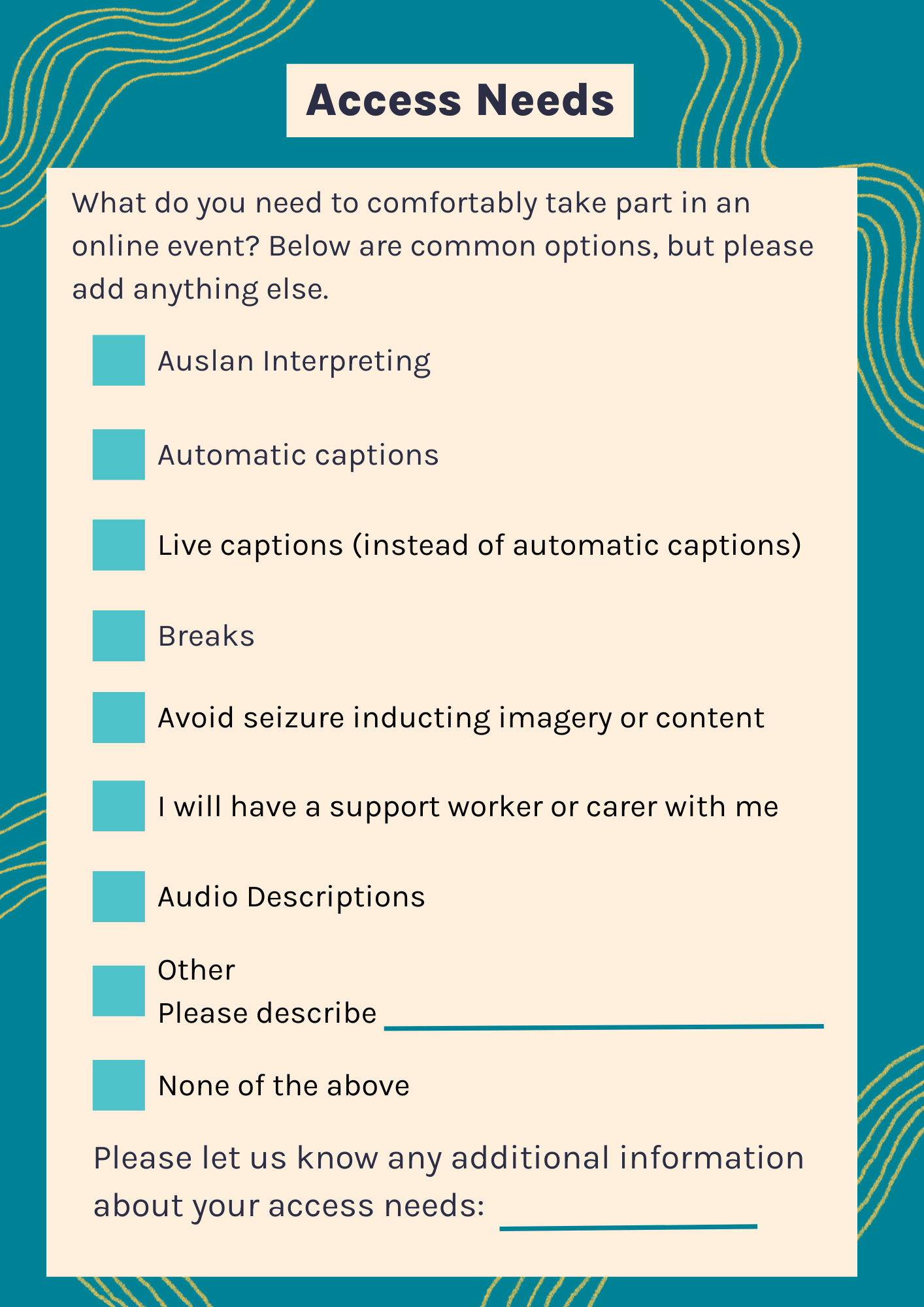
It can be confronting to hear that the space you created was not accessible for someone, but it’s important feedback that can help improve your practice and the accessibility of future events and meetings. A few tips:
- Be open and curious about the feedback the young person gives you and validate the things they say and have experienced.
- Don’t get defensive.
- Don’t make excuses. Rather, thank them for their feedback and assure them you're committed to improving the accessibility of your events and services.
- Apologise for the space not being accessible
- If the young person is willing, you could ask them for specific feedback on how to make the space more accessible next time or allow them to give their feedback in a written way if they want some time to think about it.
- It’s best practice to work with the young person to find a solution, however it’s not the young person's sole responsibility to do so.
Heading reads: Disabled young people have told us. Quotes from disabled young people read:
- Trust us
- Every disabled person has a different idea of what they're comfortable talking about and doing
- There's not a solution to every problem
- Be open to learning and listening
- Follow through with what you said you would do
- Disabled people are the experts on their own disability and their own access needs
- Don't assume anything
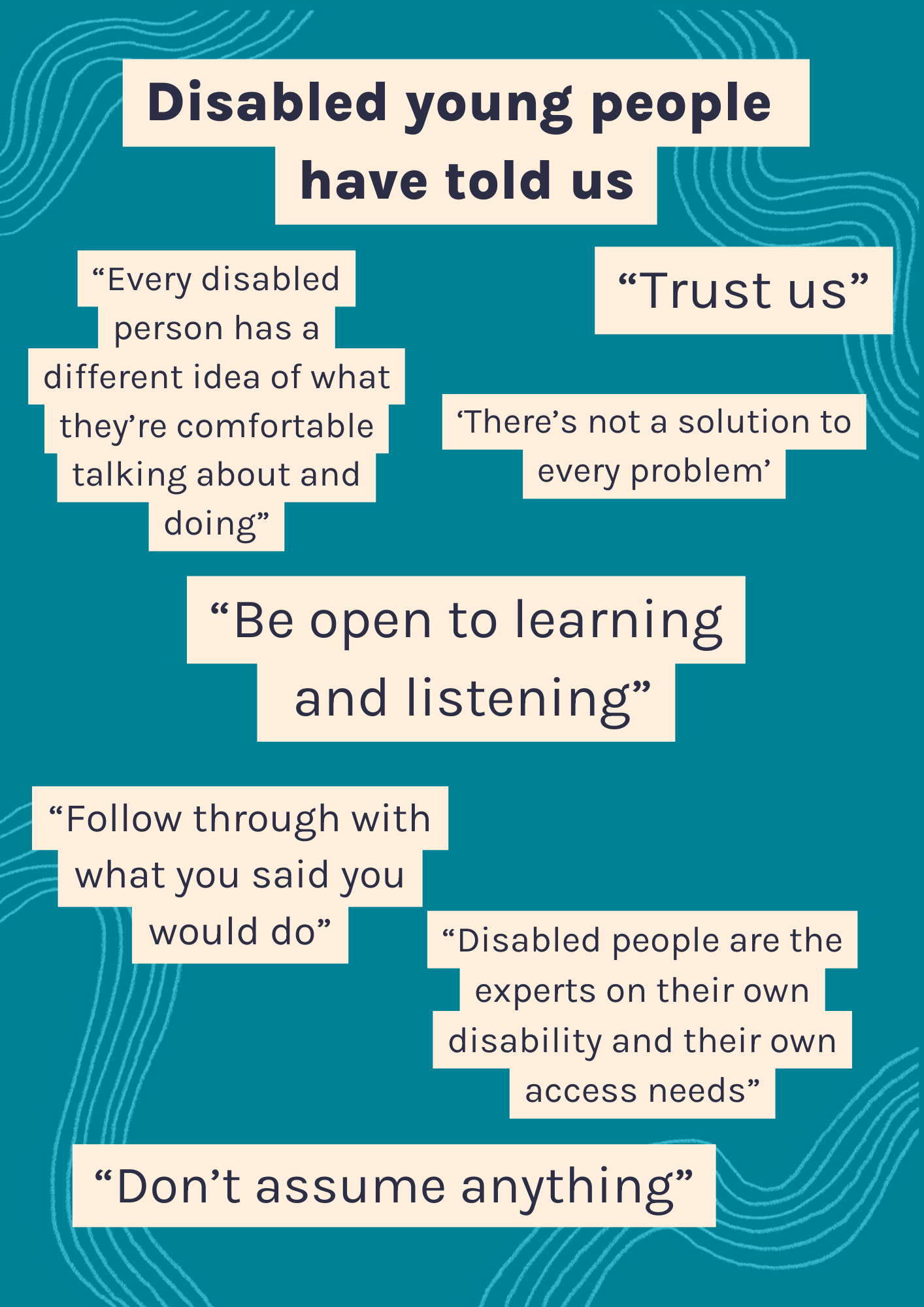
If you’re unable to meet someone’s access needs, you need to let them know.
We don’t recommend doing this in a group setting, rather, privately in a way that works for them. Tell them the limitations of the venue or event you’re inviting them to in a respectful and understanding way. This gives them agency to decide whether or not to continue with their decision to participate.1
Example scenario:
A disabled young person wants to attend a group you’re running. When you ask them for their access needs, they tell you they have airborne reactions and need the venue to be scent and chemical free. The youth drop-in centre is currently being renovated and painted, so there are strong paint fumes.
You go back to the young person and say, “thanks for letting me know about your access needs. I’m really sorry but the centre is currently being renovated and there will be strong paint fumes in the space when we have our meeting planned.’
Let the young person know that you can make this event a hybrid event so they can join online if that works for them. Let the young person know that this access limitation will be considered in the future, and you’ll aim to hold the next meeting at a different venue if renovations aren’t complete.
A photo of a disability car spot.
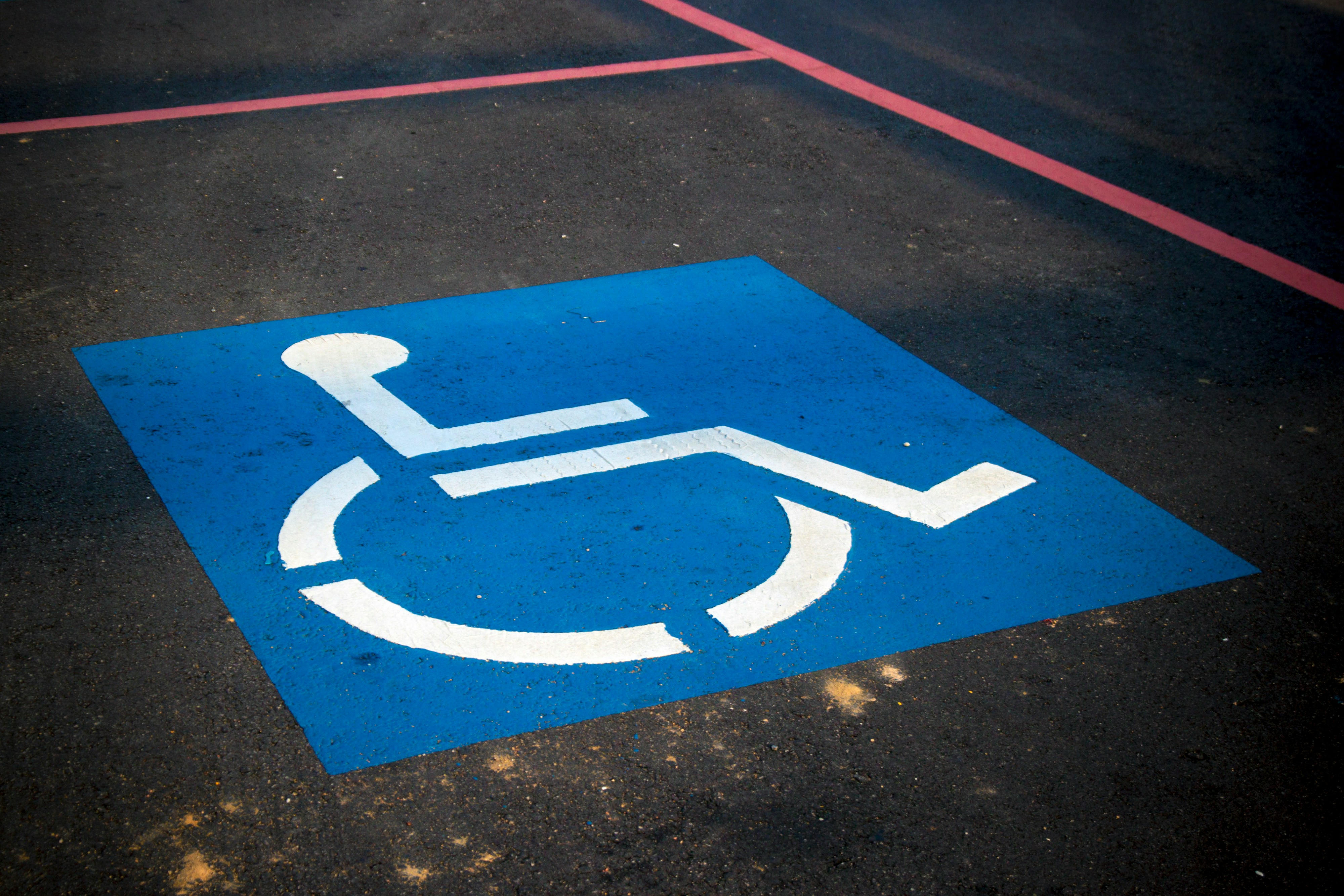
- Youth Disability Advocacy Service. (2023). Planning Accessible Events and Activities. https://www.yacvic.org.au/ydas/resources-and-training/together-2/actions/planning-accessible-events-and-activities/
- Autistic Self Advocacy Network. (May 2019). Conflicting Access Needs.https://autisticadvocacy.org/wp-content/uploads/2019/05/PADSA-Resource-Guide-_Conflicting-Access-Needs.pdf
